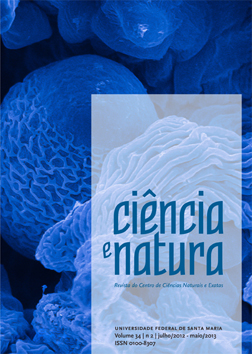ELABORATION OF THE GEOMORPHOLOGICAL MAP OF PORTO ALEGRE MUNICIPALLY - RS
DOI:
https://doi.org/10.5902/2179460X9345Abstract
The aim of this work is to identify relief compartments in Porto Alegremunicipality, Rio Grande do Sul State capital. Therefore, this research’sobjective is to elaborate a geomorphological mapping, scale 1:50.000,to identify different relief structures and the main aspects of its shaping,lithology and morphogenesis. In order to achieve that, one has tocharacterize the regional geological and geomorphological scene, characterizeand map different relief shapes through its morphometric,morphological, morphogenetic and morpho-chronological elements.The analysis follows Ross (1992) and aim to express cartographicallythe relief in each morphostructure. The following methodology wasapplied: bibliographical research, digital cartographic base and mor phometricmaps elaboration, aerial photographs and satellite imagesanalysis and mapping the relief elements. Regarding regional aspects,Porto Alegre is bounded by “Planalto Uruguaio Sulriograndense” (aplateau, a higher relief ) which formation consists of crystalline rocksand the “Planície Costeira” (plain, lowland, with sedimentary originand intake of higher lands sediments from “Depressão Periférica”).The following relief patterns were identified into this morphosculpture:hills; low hills; terrace; plains and flat areas of anthropogenic origins. The higher and steeper areas belong to hill patterns locatedon the municipality’s central area, on a northeast-southwest directedstripe. The flatter and lower lands belong to plain patterns located inthe south and north of the municipality.Downloads
Downloads
Published
How to Cite
Issue
Section
License
To access the DECLARATION AND TRANSFER OF COPYRIGHT AUTHOR’S DECLARATION AND COPYRIGHT LICENSE click here.
Ethical Guidelines for Journal Publication
The Ciência e Natura journal is committed to ensuring ethics in publication and quality of articles.
Conformance to standards of ethical behavior is therefore expected of all parties involved: Authors, Editors, Reviewers, and the Publisher.
In particular,
Authors: Authors should present an objective discussion of the significance of research work as well as sufficient detail and references to permit others to replicate the experiments. Fraudulent or knowingly inaccurate statements constitute unethical behavior and are unacceptable. Review Articles should also be objective, comprehensive, and accurate accounts of the state of the art. The Authors should ensure that their work is entirely original works, and if the work and/or words of others have been used, this has been appropriately acknowledged. Plagiarism in all its forms constitutes unethical publishing behavior and is unacceptable. Submitting the same manuscript to more than one journal concurrently constitutes unethical publishing behavior and is unacceptable. Authors should not submit articles describing essentially the same research to more than one journal. The corresponding Author should ensure that there is a full consensus of all Co-authors in approving the final version of the paper and its submission for publication.
Editors: Editors should evaluate manuscripts exclusively on the basis of their academic merit. An Editor must not use unpublished information in the editor's own research without the express written consent of the Author. Editors should take reasonable responsive measures when ethical complaints have been presented concerning a submitted manuscript or published paper.
Reviewers: Any manuscripts received for review must be treated as confidential documents. Privileged information or ideas obtained through peer review must be kept confidential and not used for personal advantage. Reviewers should be conducted objectively, and observations should be formulated clearly with supporting arguments, so that Authors can use them for improving the paper. Any selected Reviewer who feels unqualified to review the research reported in a manuscript or knows that its prompt review will be impossible should notify the Editor and excuse himself from the review process. Reviewers should not consider manuscripts in which they have conflicts of interest resulting from competitive, collaborative, or other relationships or connections with any of the authors, companies, or institutions connected to the papers.






